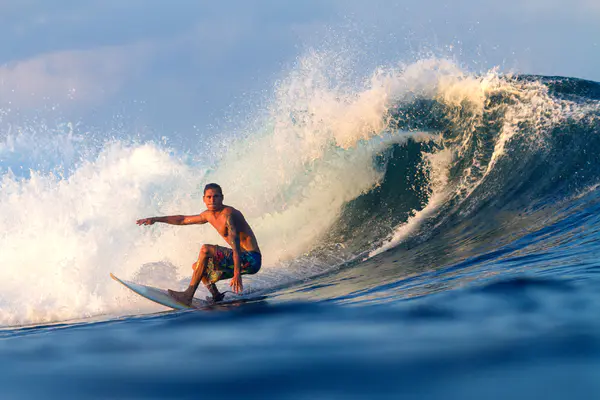Surfing is a thrilling water sport enjoyed by millions around the world. One term that is frequently used in the surfing community is “break.” This term is essential for understanding how waves form and how surfers ride them. In this comprehensive guide, we will explore what “break” means in surfing, the different types of breaks, how they are formed, and their significance in the sport.
Understanding the Concept of a Break
In surfing, a “break” refers to the point where a wave starts to break, or collapse, creating the ideal conditions for riding. This process occurs when the swell interacts with the ocean floor or an obstruction, causing the wave to rise, peak, and ultimately break. Surfers seek out breaks because they provide the right conditions for riding waves.
Types of Surf Breaks
There are several types of surf breaks, each offering unique challenges and experiences. The main types include beach breaks, reef breaks, point breaks, and shore breaks.
Beach Breaks
Beach breaks occur when waves break over a sandy bottom. These are common in many coastal areas and are typically more forgiving for beginner surfers. The sand shifts with tides and currents, causing the waves to break in different spots each day.
Reef Breaks
Reef breaks happen when waves break over a coral or rock reef. These breaks offer more powerful and consistent waves but can be hazardous due to the hard reef below. Experienced surfers often seek out reef breaks for their high-quality waves.
Point Breaks
Point breaks occur when waves break along a point of land, such as a headland or a jetty. These breaks provide long, smooth rides and are favored by surfers looking for a more extended wave experience. The waves peel off the point, creating a predictable and enjoyable ride.
Shore Breaks
Shore breaks happen when waves break directly onto the shore. These waves can be powerful and dangerous, as they break in shallow water. Shore breaks are often popular for body surfing but can be risky for stand-up surfing.
How Waves Form and Break
Waves are formed by the wind transferring energy to the water’s surface. As this energy travels across the ocean, it creates swells. When these swells encounter the ocean floor or an obstruction, they begin to break. Several factors influence how and where a wave will break.
Swell Direction and Size
The direction and size of the swell are crucial in determining how a wave will break. Swells coming from a favorable direction and of a certain size will create the best conditions for surfing.
Ocean Floor Topography
The shape and composition of the ocean floor play a significant role in wave formation. A gradual slope will produce gentler waves, while a steep slope can create powerful, barreling waves.
Tides and Currents
Tides and currents can affect the breaking point of waves. High tides may push the break further inshore, while low tides can expose more of the ocean floor, altering the wave’s characteristics.
See Also: What Is a Kook in Surfing Terms
The Importance of Breaks in Surfing
Breaks are essential for surfers because they determine the quality and rideability of waves. Understanding the different types of breaks and how they form allows surfers to choose the best spots for their skill level and preferences.
Choosing the Right Break
Surfers must select breaks that match their skill level. Beginners should look for beach breaks with smaller, more manageable waves. Advanced surfers may seek out reef or point breaks that offer more challenging conditions.
Safety Considerations
Safety is paramount when surfing different breaks. Surfers must be aware of the potential hazards at each type of break, such as rocks, reefs, and strong currents. Proper knowledge and preparation can prevent accidents and injuries.
Famous Surf Breaks Around the World
Many surf breaks have gained fame for their exceptional waves and challenging conditions. Here are some renowned surf breaks that attract surfers from around the globe.
Pipeline, Hawaii
Pipeline is one of the most famous reef breaks in the world. Located on Oahu’s North Shore, it is known for its powerful, barreling waves that challenge even the most experienced surfers.
Teahupo’o, Tahiti
Teahupo’o is infamous for its heavy, hollow waves that break over a shallow reef. It is considered one of the most dangerous waves in the world, attracting elite surfers looking for an adrenaline rush.
Jeffrey’s Bay, South Africa
Jeffrey’s Bay, or J-Bay, is renowned for its long, fast, and consistent point break waves. It is a favorite destination for surfers seeking long rides and perfect barrels.
Mavericks, California
Mavericks is a legendary big wave spot located off the coast of Northern California. This break produces massive waves that can reach over 60 feet, drawing big wave surfers from around the world.
Surf Breaks and Surf Culture
Surf breaks are more than just physical locations; they are integral to surf culture and community. Surfers often develop a deep connection to their local breaks and build communities around them.
Localism and Surf Etiquette
Localism refers to the phenomenon where local surfers feel a sense of ownership over their home breaks. While this can create a tight-knit community, it can also lead to tensions with visiting surfers. Understanding and respecting local surf etiquette is essential for maintaining harmony in the lineup.
Environmental Considerations
Protecting surf breaks and the surrounding environment is crucial for the sustainability of the sport. Surfers often take active roles in conservation efforts to preserve their favorite breaks and the marine ecosystems they depend on.
Conclusion
Understanding what a break means in surfing is fundamental for anyone interested in the sport. Breaks determine the quality of waves and the overall surfing experience. By learning about the different types of breaks, how they form, and their significance, surfers can make informed decisions about where and when to surf. Whether you’re a beginner or an experienced surfer, knowing about breaks will enhance your appreciation and enjoyment of this incredible sport.

